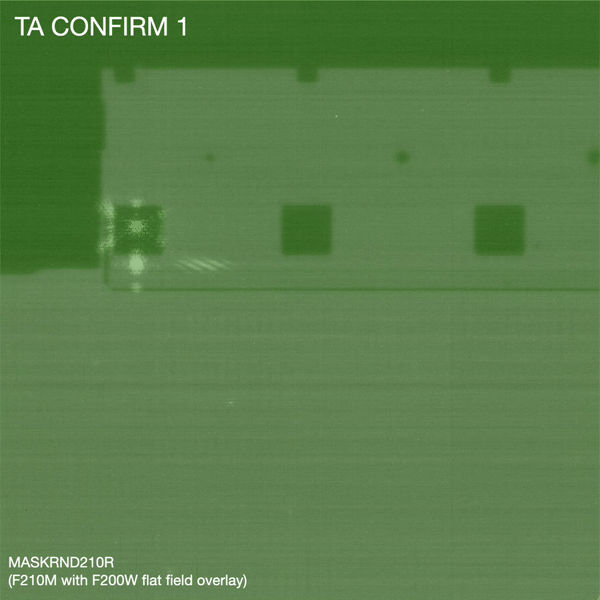NIRCam Coronagraph Astrometric Confirmation Images
The JWST NIRCam coronagraphic imaging template offers an astrometric confirmation image option to allow users to infer the location of occulted objects in science exposures to a precision of about 1–5 mas.
On this page
It is critical to know the position of a target behind the coronagraphic occulting mask with high precision (typically a fraction of a pixel). The relative position or orientation of any detected surrounding structure or potential companion can then be measured accurately. As one example, knowing the position of a putative companion around a nearby, bright host star with high precision is critical for understanding whether the object is bound or not, and if so, for measuring its orbital properties over time.
Furthermore, the expected contrast performance is dependent on how accurately a host target is placed behind the center of an occulting spot or the middle of an occulting bar. The accuracy of small angle maneuvers in the target acquisition (TA) process for NIRCam can have uncertainties of up to 20 mas since the NIRCam coronagraph target acquisition subarrays are located at distances of 7.1"–14” from the centers of the occulting masks. For these reasons and others, coronagraphic observations with NIRCam provide an optional way to obtain full frame images before and after target acquisition, thus permitting an accurate reconstruction of where the target acquisition process placed the target behind the chosen occulter.
Astrometric confirmation image procedure
The NIRCam coronagraphic imaging template provides an option to request that astrometric images be obtained with a given science observation. Specifically, an observer can request (1) a first exposure with the host star or galaxy visible in the target acquisition field (after the target acquisition subarray is read out but before the object is placed behind the occulter) and (2) a second exposure after the host star or galaxy is placed behind the occulter and the science exposures have been acquired, as shown in Figure 1.
The first exposure allows the observer to calculate precisely the location of the object of interest (not occulted at first) relative to other objects visible in the field. The second exposure then allows the observer to infer the position of the occulted object behind the coronagraph mask after completion of the target acquisition offset preceding the science observation. While science observations can in certain cases be taken in full frame, taking these astrometric confirmation images is the only way to accurately know (typically to a fraction of pixel) the position of the target of interest (host star or galaxy) during the science exposures.
Astrometric confirmation images must be obtained using the target acquisition filters: either F210M in the short wavelength channel or F335M in the long wavelength channel. Images are collected in only one detector: A2 for MASK210R, A4 for MASKSWB, and A5 for the LW occulters. However, astrometric confirmation images can be obtained with user-selected detector readout patterns, numbers of groups per integration, and numbers of integrations per exposure. This information is specified in the appropriate section of the NIRCam coronagraphic imaging observation template in APT, and appropriate exposure specifications can be obtained by performing calculations in the JWST Exposure Time Calculator.
Upper panels: example of astrometric confirmation images for the SW channel using MASK210R. The first astrometric confirmation image (left panel) is taken with the host star in a target acquisition field (the star of interest is indicated by the blue arrow). Simultaneous imaging of the host star and background field (purple stars and galaxies) provides the opportunity to measure the absolute position of the host star with respect to the background field at very high precision. The second astrometric confirmation image (right panel) is taken with the host star behind the occulter and allows the observer to infer the position of the occulted object behind the coronagraph mask after completion of the target acquisition and science observation. Images are collected using only one detector (in this specific example A2. If MASKSWB is used, images are collected using detector A4).
Lower panels: same as upper panels, but the for the LW channel using MASK335R. The first astrometric confirmation image (left panel) is taken with the host star in a target acquisition field (the star of interest is indicated by the red arrow). The second astrometric confirmation image (right panel) is taken with the host star behind the occulter.
An example use case
Among other things, the NIRCam coronagraphs may be used to search for sub-stellar companions around young stars in Taurus, located at typical distances >150 pc with typical proper motions ~10 mas/yr. In order to distinguish gravitationally bound companions from line-of-sight objects at the 5-sigma level during one year, the position of an occulted host star must be measured with ~1.5 mas astrometric precision during a single epoch. By obtaining astrometric images before and after the target acquisition for each observation, the position of the target behind the occulter can be reconstructed, and the relative position of nearby structures can be determined to the needed accuracy (in this case thanks to the presence of many background stars in a crowded region).
References
Girard, J. H., et al., 2022, Proceedings of the SPIE, 121803Q
JWST/NIRCam Coronagraphy: commissioning and first on-sky results
Green, J. et al. 2005 "Techniques and Instrumentation for Detection of Exoplanets II", SPIE 59050L
High contrast imaging with the JWST NIRCAM coronagraph
Krist, J. et al. 2010 "Space Telescopes and Instrumentation 2010" ed. J. Oschmann et al., SPIE 77313J
The JWST/NIRCam coronagraph flight occulters
Krist, J. et al. 2009 "Techniques and Instrumentation for Detection of Exoplanets IV" SPIE 74400W
The JWST/NIRCam coronagraph: mask design and fabrication
Krist, J. et al. 2007, "Techniques and Instrumentation for Detection of Exoplanets III", SPIE 66930H
Hunting Planets and Observing Disks with the JWST NIRCam Coronagraph


